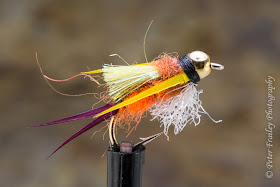Part 8 of 11
When I was photographing this set of flies I noticed that all of them, except one, are beadheads. Hmmm. Interesting.
This first set includes flies that were fished like, well, woolly buggers. This means upstream a bit, across stream, or downstream. They can be twitched, nearly dead-drifted, or stripped like a streamer. Lead wire would have worked for weight too, but all of these had beadheads to help get them down. They were successful during the day and in the evening. In fact, even when there were rising fish in the evening (to which John delivered his CDC caddis), these big fluffy high-impact flies outperformed a dry fly.
 |
| In both the olive woolly bugger above and the black one below, a little bit of flash seemed to help attract fish. Fly tied by Paul DiNolo |
 |
| Fly tied by Paul DiNolo |
 |
| Marabou Beadhead Muddler tied by Paul DiNolo |
The two flies below are two versions of the One Feather Fly. I love to tie and fish this simple fly, and previously posted step-by-step directions.
Each is made from one feather from the rump area of a pheasant, quail, or partridge. Colors vary considerably, and each fly seems to come out slightly different because each feather is slightly different.
 |
| Tied by Peter Frailey |
 |
| Tied by Peter Frailey |
This next set of weighted flies found their was to the bottom fly on a hopper-dropper combination. Or, they were used as a nymph under a strike indicator.
 |
| "Hare and Herl Bugger" tied by Peter Frailey |
Jim used the Hare and Herl Bugger with great success, often presenting deep and on the swing. He had one successful night where he caught a trout on nearly every cast, or so it seemed to the rest of us, who were not as successful.
 |
| "Wonder Bug" tied by Peter Frailey |
The Wonder Bug was my most used fly. I fished it mostly about 6 feet below a foam strike indicator. And after I decided to give hopper-dropper fishing a try, this was my dropper. Tying instructions are very simple. Basically a clipped hackle woolly worm with biots for a tail. Under the herl is 10 wraps of lead. I posted step-by-step instructions last year on my Web site.
 |
| 20-incher. Tied by John Morrison. |
These were the first samples of the 20-Incher tied by John. They were tied on our "rainy day Tuesday". The 20-Incher had been used on Sunday and Monday by Rob as a dropper. But since Rob does not tie flies, it was up to John to figure out how to tie this pattern. Thankfully, our Internet connection was good and he was able to check out a little video.
 |
| Some king of little nymph. Commercially tied. |
This is an example of one of the many tiny nymphs Rob used, and which filled his fly boxes. I have no idea what this one is called, but it measures only 11mm (eye to bend) and has so many ingredients tied to it that I can only imagine how difficult it is to tie.
No comments:
Post a Comment
comment here